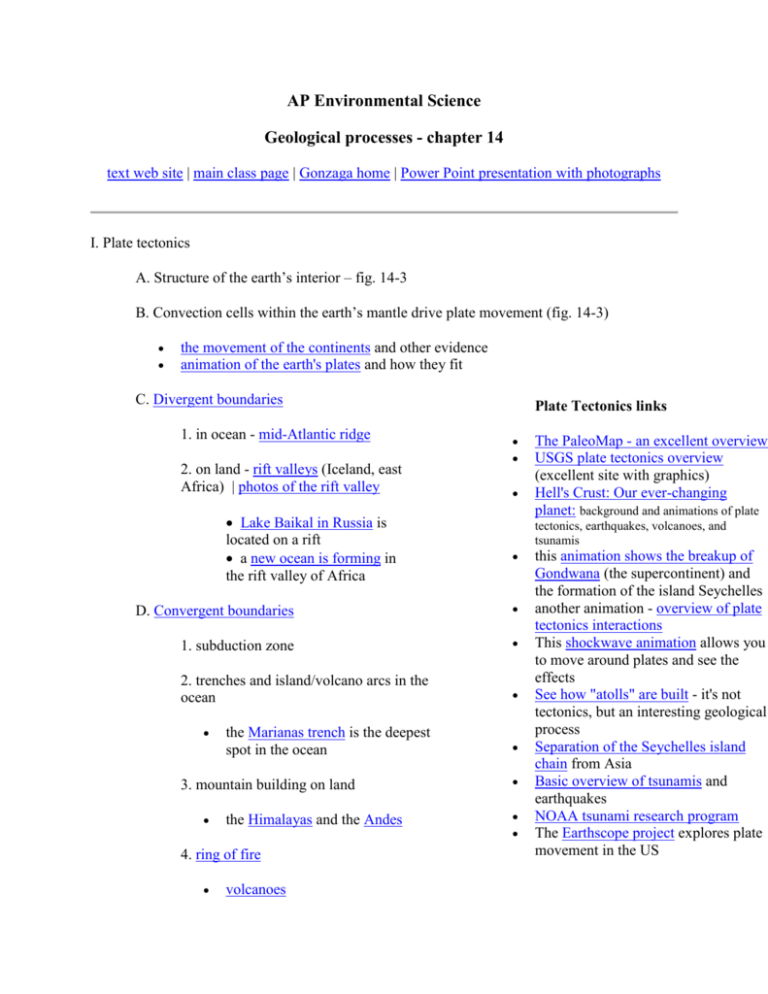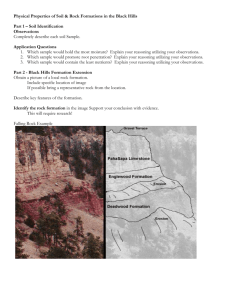AP Environmental Science notes - chapter 14
advertisement

AP Environmental Science Geological processes - chapter 14 text web site | main class page | Gonzaga home | Power Point presentation with photographs I. Plate tectonics A. Structure of the earth’s interior – fig. 14-3 B. Convection cells within the earth’s mantle drive plate movement (fig. 14-3) the movement of the continents and other evidence animation of the earth's plates and how they fit C. Divergent boundaries 1. in ocean - mid-Atlantic ridge 2. on land - rift valleys (Iceland, east Africa) | photos of the rift valley Lake Baikal in Russia is located on a rift a new ocean is forming in the rift valley of Africa Plate Tectonics links tectonics, earthquakes, volcanoes, and tsunamis D. Convergent boundaries 1. subduction zone 2. trenches and island/volcano arcs in the ocean the Marianas trench is the deepest spot in the ocean 3. mountain building on land the Himalayas and the Andes 4. ring of fire volcanoes The PaleoMap - an excellent overview USGS plate tectonics overview (excellent site with graphics) Hell's Crust: Our ever-changing planet: background and animations of plate this animation shows the breakup of Gondwana (the supercontinent) and the formation of the island Seychelles another animation - overview of plate tectonics interactions This shockwave animation allows you to move around plates and see the effects See how "atolls" are built - it's not tectonics, but an interesting geological process Separation of the Seychelles island chain from Asia Basic overview of tsunamis and earthquakes NOAA tsunami research program The Earthscope project explores plate movement in the US Volcano under the city - explore volcano "anatomy" Tsunamis are caused by the subduction zone along the N.A. west coast (pictures and explanation) more on tsunamis one of the largest tsanamis on record struck Lituya Bay, Alaska in 1958 Mt. St. Helens and volcano cam | Crater Lake in Oregon formed as a result of a large eruption 1000 years ago. Smithsonian Volcano page (links to a Google Earth interactive of worldwide volcanoes!!) Supervolcano (PBS program/website) Google-earth earthquake monitor Tour of National Park System geological features and Park Service Geologic Wonders Geology of New Zealand has lots of good stuff Geology of the Colorado Plateau Geology of the National Parks - 3-D views | another site National Park Volcanoes IcEarth - tour the causes and effects of various "natural distasters" E. Transform faults 1. boundary between sections of divergent plates 2. earthquakes (fig. 14-19, 14-20, 14-21 Images of earthquake damage Digital world tectonic activity map USGS earthquake hazards program Tsnamis - 14-22 II. Non-tectonic processes produce most surface features A. glaciation Mystery of the Megaflood - explore geological evidence of post-glacial flooding in North America Quiz yourself - identify geological origin of landscapes Explore glacial features in the National Parks 3-D images of glaciers and other features in national parks (USGS) The "Driftless Area" is a region in the midwest that was not glaciated B. mechanical weathering/erosion by wind and water Explore coastal geology in the National Parks C. chemical weathering D. The geologic history of the mid-Atlantic Geology of Virginia (JMU) | Geology of Virginia (William and Mary) Virginia Rocks and Ridges Geologic Features of Maryland | Geology of Maryland Geology of Rock Creek Park Satellite image of Maryland and northern VA National Park Service Nature and Science overviews: Shenandoah | George Washington Parkway | Mid-atlantic parks geology Tour the geology of US National Parks Geology of the National Monuments on the Mall | Geology of the National Mall and Washington DC The Tuscarora formation: bedrock of the mid-Atlantic mountains III. The rock cycle (fig. 14-13) mineral identification animation of the rock cycle - with lots of good background info | another animation | an another A. igneous rock is formed beneath the earth’s surface in a molten state B. sedimentary rock forms from sediments weathered off existing rock/soil and deposited in water layers of rock can be seen at Sideling Hill, MD C. metamorphic rock is produced when existing rock is heated enough to change its form IV. Soils "SK worm" answers your soil questions The soil biology primer is a good overview of the living components of soils State Soils Web soil survey - interactive maps give detailed info about local soil conditions Soils exhibit at the Natural History Museum A. layers – fig. 12-A, p. 290 1. Surface layer (O horizon) – surface litter 2. A horizon – topsoil – mostly organic (varies with soil type) 3. B horizon – subsoil 4. C horizon – parent material – lies on the bedrock in desert and near-desert regions, the soil crust is very thin and fragile. Check out the basics (soil 101) and some pictures more about how soils form B. soil organisms create soil and add nutrients to it C. soil profiles vary in different biomes and are a determining factor for biome types D. soil types (more here - info on the 12 soil "orders", range maps, etc) 1. clay 2. sand 3. silt 4. soils are a mixture of the three types, which results in a complex assortment of soil texture 5. soils with roughly-equal mixtures are called loams 6. differing properties result from varying combinations of the three types soils are important for agriculture, construction, mudslides, fires, and other things E. erosion - chap 12 1. three types 2. historical examples - dust bowl 3. seriousness of erosion worldwide – fig. 12-16 4. desertification is a related problem (fig. 12-17) both of these problems are related to water over-use and over-grazing by livestock the Aral Sea provides a frightening example of the worstcase scenario we will discuss this further with regard to resource use and food production 5. solutions to soil erosion problems farming adjustments - p. 304-308 animal and artificial fertilizers can present a host of problems – more on this when we discuss water pollution Natural Resource Conservation Service (a program of the USDA) addresses erosion in the US






